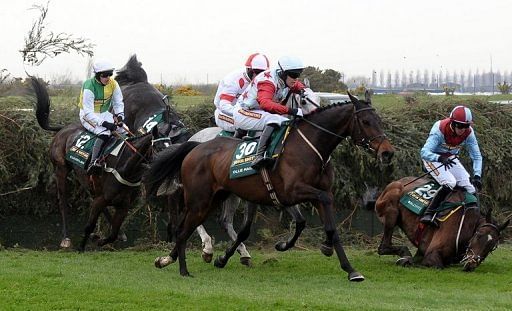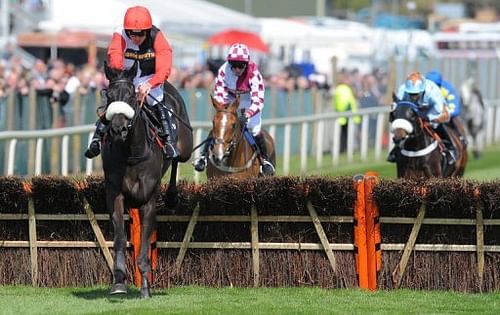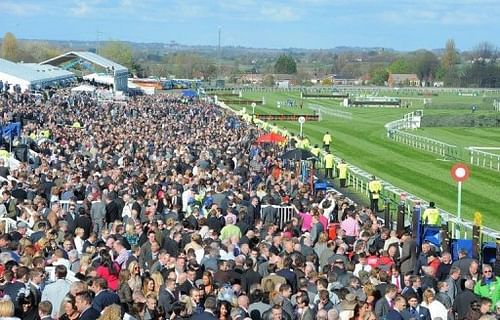
Changes aim to make Grand National safer
PARIS (AFP) –

Ballyfitz (right) ridden by David England falls at Becher’s Brook during the 2010 Grand National at Aintree. As the annual Grand National race meeting opens at Aintree on Thursday, final preparations are underway for Saturday’s world-famous steeplechase following major changes to the layout of the course.
As the annual Grand National race meeting opens at Aintree on Thursday, final preparations are under way for Saturday’s world-famous steeplechase following major changes to the layout of the course.
It is probably not overstating it to say that this year’s running of the Grand National is the most important renewal in its often turbulent and eventful history.
With four horses having died during the past two races, the Aintree authorities have taken measures to try to ensure that such upsetting scenes for the public do not occur again.
The deaths of two highly-fancied runners last year – Cheltenham Gold Cup winner Synchronised and the talented According to Pete – brought out not only the traditional hysteria from those who are against jumps racing in any form but also more reasoned voices.

Neptune Collonges (centre), ridden by Daryl Jacob, on its way to winning the 2012 Grand National at Aintree. With four horses having died in the past two runnings the Aintree authorities have taken measures to ensure that such upsetting scenes for the public do not occur.
Previous reforms such as limiting the field to 40 runners and raising the bar in terms of eligibility to run after a series of no hopers ended their days victim to one of the 29 imposing fences – the race is over 30 fences but the water poses no danger not even from drowning – proved willingness on the authorities part.
However, they were not enough to ensure safe passage.
This time round a whole raft of changes have been made even down to the pre-race parade, where the horses will be placed in numerical order before leaving the paddock, rather than as before sorting themselves out on entering the track.
This will reduce the time spent in the lead-up to the race which can make the horses even edgier.

Big Bucks (left), ridden by Ruby Walsh, jumps the last fence in the Liverpool Hurdle at Aintree last year. There have been significant moderations to the Grand National fences with plastic stakes replacing the hard wooden ones hidden inside the fences which usually meant a horse who hit the obstacle never stayed on its feet and hit the ground on the other side at great risk.
There have been significant moderations to the fences – save the three open ditches – with plastic stakes replacing the hard wooden ones hidden inside the fences which almost 100% of the time meant a horse who hit the obstacle never stayed on its feet and hit the ground on the other side at great risk.
The traditional hate fence of the race is Becher’s Brook which has once again had the landing side raised.
The 2013 version would be unrecognisable to the man who gave the jump its name, amateur jockey Captain Martin Becher, who hid in the then water filled Brook when he was unshipped from Conrad in 1839.
Afterwards he remarked drily: “Water tastes disgusting without the benefits of whisky.”

Graham Lee on Bedlam Boy falls at the last fence in the John Smiths Maghull Novicesrace at Aintree in 2010. The deaths of two highly-fancied Grand National runners last year – Cheltenham Gold Cup winner Synchronised and the talented According to Pete – brought out not only the traditional hysteria from those who are against jumps racing in any form but also more reasoned voices.
However, there are two measures that have raised the hackles of the racing fraternity and indeed provoked a debate whether they will be effective in reducing the chances of harm coming to both rider and horse.
The start of the National has been fairly chaotic throughout its history most notably when Esha Ness won the race that never was in 1993 because of a false start under the tragic-comic starter Captain Keith Brown which saw nine of the 39 runners left at the start while 30 pointlessly charged off.
Last year there were two false starts without the same catastrophic result, though, of little import to the connections of the two dead horses, thus this year the start has been brought forward 90 yards, to allow the jockeys to hear the starter more clearly away from the crowd.
The authorities also believe that it will reduce the chances of the annual cavalry charge to the first and avoid the usual carnage, but many venture to disagree.

The first day of the 2012 Grand National meeting at Aintree. The start of the Grand National has been brought forward 90 yards, to allow the jockeys to hear the starter more clearly away from the crowd.
“Riders will have less time to sort themselves out and I think they’ll go even quicker,” said Bob Champion, who memorably rode Aldaniti to victory in the 1981 National after recovering from cancer.
“The start of the National is an important moment in any jockey’s life. The world and his wife are watching and you don’t want to mess it up and get left.”
However, the jockeys have also been instructed that they too should stay calm before the start and help the starter as much as possible – again something that has riled the riders and trainers alike at its patronising tone.
“It’s a horse race, isn’t it?” commented Donald McCain Junior, trainer of 2011 winner Ballabriggs.
However, Gavin Grant, chief executive of the animal welfare charity the RSPCA, says that these protests aside everyone is aware that there is a huge amount riding on everyone shouldering their respective responsibilities.
“The Grand National is on trial,” Grant told the Mail on Sunday.
“I simply don’t think the public will tolerate another National like the ones we’ve had the last few years and I think everybody involved in the race this year is approaching National weekend with a degree of nervousness.”
“To many inside the racing industry, the death of Synchronised with the champion jockey, Tony McCoy, on board, was a final moment to say, ‘It has got to change’.”